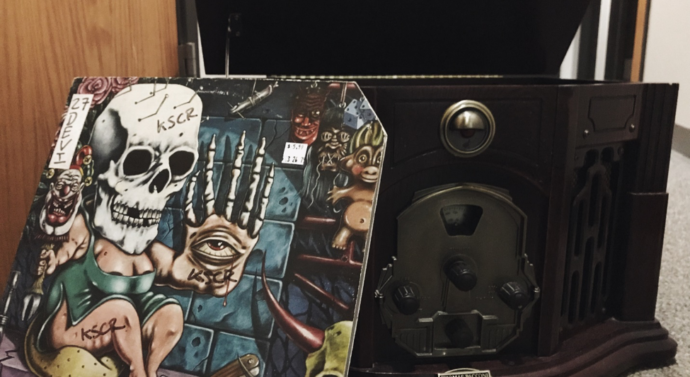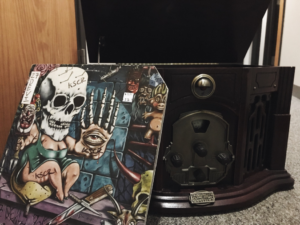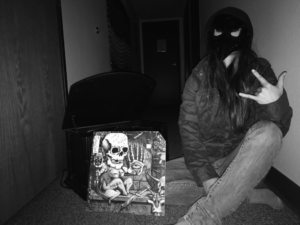
Mac’s Tracks: Can you stomach horror music? Here’s why it’s not really mainstream
Editorial October 26, 2018, Comments Off 101The following is an edition of Mac’s Tracks, The Mirror’s music column. All views, thoughts and opinions belong solely to the author and do not necessarily represent those of the Drury Mirror.

Photo via Maclen Johnson.
Horror and thriller movies are ever-popular in today’s culture. New takes are produced every year, especially around Halloween. Classics include “The Nightmare on Elm Street,” “The Exorcist” and “The Shining,” with contemporary additions like the newest “It,” “Get Out,” “A Quiet Place” and “Hereditary.” These films are ingrained in our minds, and while not everyone goes to see them, there is no real taboo against doing so.
So, what is different about horror music? Just like horror movies, horror music is not a genre that everyone gets in to. The lyrics are dark, often bordering on threatening and offensive, with discordant, heavy instrumentals that are anything but reassuring.
The rise of horror music’s popularity coincides with the movie industry’s embrace of darker material. The 1950s treated monsters and Halloween themes comically where the threat level was low, such as in Bobby “Boris” Pickett’s “Monster Mash.” Multiple rappers put up songs for the “Elm Street” franchise, such as the Fat Boys’ “Are You Ready for Freddy.” These are all relatively friendly for the public and do not feature abrasive subject matter, allowing them to mesh with mainstream movies and pop appeal. The following styles and artists step over this line quite definitively.

Photo via Maclen Johnson.
Horrorcore
Horrorcore is one of the most prominent subgenres that really tackles gory music. A branch off hip hop, horrorcore artists include the infamous Insane Clown Posse, the increasingly popular $uicideboy$, Gravediggaz, and, in a very generous definition, Eminem. It originated in New York City not long after gangsta rap. It features supernatural aspects like demons and ghouls with a good blend of real-life monsters such as Esham’s “Boomin’ Words from Hell,” which compared his home city of Chicago to hell itself. ICP and Geto Boys are responsible for bringing this style into the mainstream, however briefly.
Horror punk
Horror punk works along similar lines and has found more consistent success than horrorcore. The Misfits are a figurehead of the genre. Mixing gothic influence with punk rock and morbid imagery, bands of this genre are often confused with Psychobilly or Deathrock due to a shared influence of ‘50s doo-wop fashion. While horror punk motifs, like skeletons, all black outfits and sci-fi elements are common at Hot Topic nowadays, the music delves into murder and other acts of violence yet retains an oddly upbeat sound.
Witch house sprouted up in the late 2000s. It is a grating blend of industrial goth and dark ambient with vocal samples distorted beyond recognition that have faced controversy for its previous genre name. The genre draws influence from Twin Peaks and occult symbolism like pentagrams, crosses and Illuminati triangles. Likened to being locked in a haunted house while blindfolded, witch house twists the rise of vaporwave with a deeply eerie aesthetic.
Gabba music
Gabba is heavy electronic music that began in the Netherlands (coincidentally, most dark metal bands find their origins here as well). ID&T, a Dutch entertainment company, organized raves and parties in the 1990s to get people listening to gabba music. It features sped-up aggressive drums, distorted synths and lyrics rife with references to drugs and violent acts. Although gabba has no political message, it faced heavy backlash after neo-fascists embraced it. Gabba artists have publicly come forward to denounce these fans and remind their audience that the music has no affiliations with the movement.
These subgenres reflect the darkest elements of humanity and force the listener to feel it. Horror movies are freaky, and some even stick with you for years down the line (Monster House and Coraline struck a chord with my 10-year-old self). But horror lies in the music, too: Alfred Hitchcock’s “Psycho” would not have the same impact without Bernard Hermann’s haunting accompanying score. Dissonance, high frequencies, distorted vocals and heavily-altered beats create something that is off-kilter and uncomfortable to listen to.
Maybe there is a distance that we can put between ourselves and a movie that is not there for music. With movies, we are comforted in knowing that the horrors portrayed on screen will stay there. The dissonant chords of gabba and the painful lyrics of horrorcore are harder to separate from reality. These genres are designed to shock, and they succeed in this mission.
This week’s Mac’s Tracks will update to include some horror cuts (and a few of Pickett’s alternative monster jams), but I recommend exploring these tunes on your own time.
What are your thoughts on these darker jams? Are you a fan of horror music or do you find it distasteful? Drop a comment down below!
Written by Maclen Johnson.